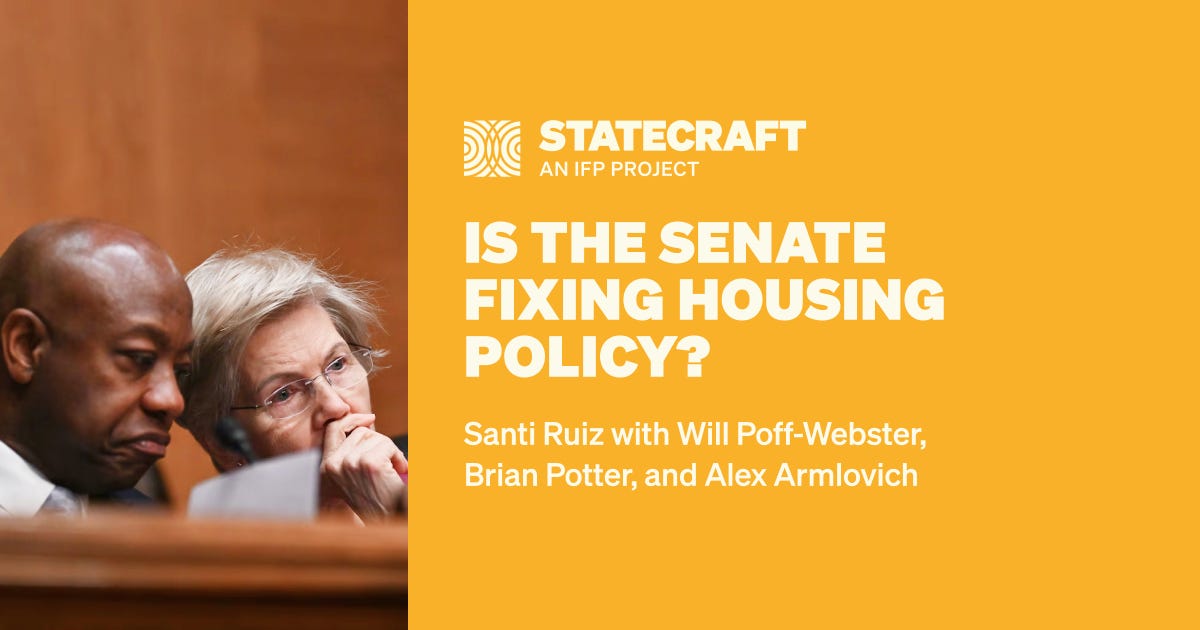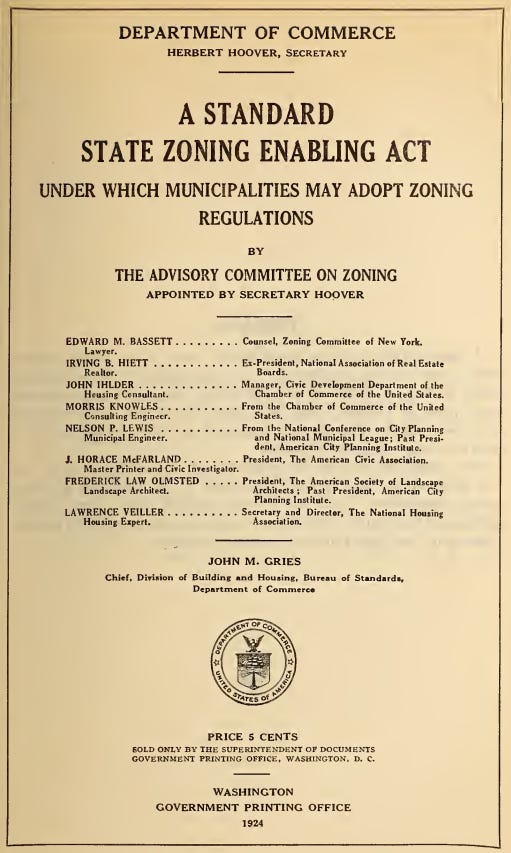Today we’re talking about housing. The ROAD to Housing Act passed the Senate Banking, Housing, and Urban Affairs Committee 24-0 in late July. Last week — despite the shutdown — it cleared the Senate. It’s a package of 27 pieces of legislation to boost housing supply, improve affordability, reduce regulatory roadblocks, and reduce homelessness.
When you zoom out a bit, what’s happened here is pretty surprising. The chair of the committee, Republican Tim Scott, and the Ranking Member, Elizabeth Warren, a Democrat, co-sponsored the bill. The bill is the committee’s first bipartisan housing markup in over a decade. Passing through committee unanimously doesn’t happen often for serious bills of this sort. I wanted to understand how this bill happened, and came to have a serious shot at passing. And I also wanted to get a better sense of what’s actually in the bill, and why it matters for housing. If you’re like me, most of the debates you hear about housing policy focus on zoning, which is a local issue — very little federal say. So what are all these pieces of legislation? Do they matter?
Joining me is an unorthodox trio:
Will Poff-Webster was legislative counsel for Senator Brian Schatz, a Democrat from Hawaii. He’s our inside guy today: he worked on the bill within the Senate. Now, he covers housing policy at IFP!
Alex Armlovich is Senior Housing Policy Analyst at the Niskanen Center. He has been working on housing issues for a long time, and his fingerprints are on parts of this bill package. He’s my advocate from the outside.
Brian Potter is Senior Infrastructure Fellow at IFP and author of Construction Physics, which I very much enjoy editing. If I can make one newsletter recommendation to you besides Statecraft, it’s Construction Physics. He has a background in private-sector home building. And has written about several of the proposals in this package.
Table of contents:
Regulatory reform
Technical assistance plus incentives
Funding and financing reform
If you’re interested in housing, check out last week’s episode:
Thank you to Harry Fletcher-Wood and Katerina Barton for their judicious transcript and audio edits.
Let me start with Will, as our inside guy. The ROAD to Housing Act is a partial acronym: the “Renewed Opportunity in the American Dream to Housing Act of 2025.”
It’s one of these classic, vaguely ridiculous congressional acronyms. I’ve heard that LLMs have made it way easier to come up with funny acronyms for bills. Is that true?
Will Poff-Webster: It’s something that people on the Hill spend time thinking about: how do you develop a catchy acronym for your bill? There have always been some staffers who have a knack for it and others who delegate to them. The LLMs definitely have that knack too. Eight out of ten of their suggestions are bad, but because two out of ten are good, it is not an uncommon way to get a bill title. One of the funny parts is, you’ll see more bills now where the title is catchy and alliterative, but it’s totally unrelated to the bill subject. You’ll see a title that makes you think it’s about ocean science and then it’s a housing bill. But it’s one of the ways that AI maybe has some positive productivity benefits. But there’s still people coming up with the acronyms the analog way, I promise.
What’s the federal role in housing policy?
Treasury Secretary Scott Bessent recently said that President Trump may declare a national housing emergency. Listeners who live in big, expensive cities — I’m in New York, we have listeners in LA — will have a visceral sense of this. But why should I think the cost of housing is a national issue? Why is it not just an issue in New York, San Francisco, and a grab bag of big cities?
Brian Potter: There’s a couple of reasons. One is that these big, expensive metro areas are huge drivers of economic growth. If you can get more people living in these places, contributing more, and growing GDP, that helps the country as a whole. The other thing is that a lot of cities are now following the path of these big metros. I live in Atlanta, which historically was a place where housing prices were relatively inexpensive. But over the last several years, they’ve ramped up. You see that in a lot of metros across the country. This problem, that was once concentrated in these expensive coastal cities, is becoming more universal.
Will: COVID has an interesting influence here. If you look at the data from Up for Growth, one of the premier national housing organizations that studies this, you see a change over the last few years. There were already trends leading to more places suffering from severe housing shortage. But [after COVID] you have more people moving out of places like California into places like Montana. If you talk to legislators in Montana who did their zoning reform work, a few thousand additional Californians had a big impact on their housing stock.
If you have a place that isn’t growing very much, and then suddenly gets an influx of work-from-home folks or folks who are leaving the city, that matters. What used to be a regional problem has become a national problem. The latest report from Up for Growth shows that most metropolitan areas in the United States now have a housing shortage.
Alex Armlovich: It is a national problem that you see spreading: wherever people want to live, and there’s bad zoning, you have a problem. Montana had maybe a 7% vacancy rate before the pandemic. Their housing stock is smaller than Queens in New York City. 50,000 Californians is enough to drive Montana’s vacancy rate to zero. Pretty soon you have to have a construction response to that.
That said, I still like to take an urban-economic-disciplined look at this. A housing affordability problem is the combination of two problems: incomes and high housing costs. You can have a place that has very low incomes and high housing cost burdens, but houses are not sold for more than it costs to build a structure. YIMBYism and zoning reform can’t solve a problem where houses are selling and renting at their construction cost. That’s a problem of people having low incomes and not being able to afford construction costs.
The wedge between costs and sale prices tells you where land-use regulations are doing the most damage. Places with high wages and high amenities — including good weather, jobs, and infrastructure — are where demand collides with bad land-use regulation. It’s an increasingly nationalized problem, and you look at that wedge to identify the spots.
Will: In these high-cost places, we are seeing an inability to build because land-use regulations are too strict to allow housing to expand at the rate you would need to accommodate the number of people who want to live there. There’s this book by Yoni Appelbaum called Stuck about a change in American life. We used to have a society where people would move all the time. They’d move to new places; they’d move within their neighborhood to a nicer house. We’ve become a society where, instead of moving to places of greater opportunity, people move to places of lower cost of living. The trends that led people to move from Mississippi to New York have now reversed. A janitor can make more money, relative to their cost of living, if they live in a low-cost place. We have turned an engine of opportunity into an engine of disaggregation of poverty. People have to move to poorer places to make ends meet. They are no longer able to access that opportunity because of the land-use regulations and zoning controls in the high-cost, high-opportunity places.
That historical point is interesting. Last night, I started this book by Stephen Eide, Homelessness in America, and he does a 101 history of homelessness. I was struck that 100 years ago, nobody thought homelessness was a problem of not enough houses or houses that are too expensive. There were cheap houses everywhere. Today, whatever you think about the causes of homelessness, a piece of that puzzle is housing costs.
Alex: You ask, “Why are substance-use disorder and severe mental illness important drivers of a core of difficult-to-treat homelessness?” Think of New York or San Francisco. If your cousin develops a mood disorder in their twenties, as so often happens, and loses their job and needs a spot to stay, middle-class people in New York — sometimes they don’t even have a spare couch, let alone a spare bedroom, or an Accessory Dwelling Unit (ADU): a garage or a basement that could be inhabited sustainably. Family networks are an important buffer. In Baltimore you can do that. In even high-income places, it’s not possible.
Will: We talk about a “housing crisis,” but there are two parts to it. There’s an affordability crisis — people can’t afford a home — and there’s a housing shortage. In some parts of the country, and for some people, particularly the lowest-income Americans, they’re never going to be able to afford a home without some assistance. They’re going to need a Section 8 voucher or another support. But in the highest-cost parts, and in a growing part of America, you need a voucher even at a middle-income level — 100% of the area median income or above — to afford a home. In places where our land use creates a massive shortage of housing, it becomes a problem for everyone. Even a middle-income person needs housing assistance. There isn’t enough assistance for all the low-income people who might be able to afford a market-rate house in a place like Minneapolis. If they live in New York, San Francisco, or Honolulu, they’re not going to be able to make it work without significant subsidy. Unfortunately that subsidy isn’t available.
Will, you mentioned Minneapolis is a relatively affordable metropolis. Brian, you were talking about metropolitan areas that don’t have these affordability issues and housing shortages. What other places are doing well?
Will: Minneapolis and Austin, Texas are two of the big standouts. Both places have a lot of people moving there. They have growing industry and job bases, but they also have recognized that they need to build more housing in order to keep it affordable for the people who live there and who want to move there. In Minneapolis, there’s affordability at the 60% area median income-level, which is significantly below average for a market-rate house. If you go to a place like Boston, New York, DC, there’s these big fights over, “We need more deed-restricted affordable units,” “We need the government to require affordable units.” That’s all well and good, but Minneapolis is doing it in the private market. That’s been a wake-up call to people on the left that there’s a big role for exclusionary zoning in causing this problem. Places like Minneapolis that have reckoned with a past of exclusionary zoning and reformed it are seeing the benefits.
Zoning is a state and local issue. Why should we agree federal law is a lever you can pull to fix housing issues across all these states and localities? Why shouldn’t we throw up our hands and say, “This is a problem for your mayor and your city council to solve”?
Alex: The case for the states is strong. I have a variant of this idea from Catholic social thought called subsidiarity: the idea that decision-making should be at the lowest level of government...
First time subsidiarity has been mentioned on this podcast and hopefully not the last. It’s an interesting and relevant concept.
Alex: These governance questions didn’t become a problem yesterday. The idea is you move a decision down to the lowest level at which it can reasonably be made. I like to add a little economist twist to that, which is, you bring it to the lowest level that internalizes most of the costs and benefits of the decision. Local governments that are small, relative to their labor market area, will tend not to internalize the consequences of growth and transportation-planning decisions that affect the entire region. If you are small, you could say, “We’re going to lock down growth here and our residents will just get jobs somewhere else. Why do we have to grow? Why doesn’t the other city grow?” You end up with this collective action problem at the regional level.
The right level for most decision-making that affects metropolitan areas is a partnership between state and local — state guardrails make sure regional interests are taken into account when local governments make transport and growth-control decisions that affect the region.
Will: To put a political lens on this, I used to work for a city councilor. It’s very hard for a councilor to come out in favor of new housing, because the voter participation rates in local elections are 5-10%. The people who show up are the people who don’t want something to change. There’s good research on this from Katherine Levine Einstein and others, that the majority of people are in favor of new housing, but the people who show up to a community meeting about it are vastly less likely to be in favor. They are more likely to be elderly homeowners who have professional degrees, as compared to the general population.
If you’re a city councilor, what you’re hearing all the time is people thinking about the cost of growth — who don’t want their neighborhood to change. That’s not what happens if you’re a governor. It’s hard to find a Not In My Backyard (NIMBY) governor. They recognize their states need to grow — or need to not be hemorrhaging population like a lot of big blue states are now. At state and federal levels, people are seeing the benefits. You have elected officials with a broad enough purview — looking at their whole state or nation — and seeing we have a problem with housing being expensive, and with a shortage of this good that we all say we want, but we make hard to get through regulation.
At the local level, often realtors’ associations will be opposed to new housing because they’ll be invested in the homeowner experience. But at the state and federal level, realtors recognize the benefits of home building. Same thing with unions: they want more work and more members. They care about growth and construction. But the more local you get, the more people see the costs and not the benefits. That’s part of what Alex is talking about here, and why it makes sense to do some of the stuff at higher levels.
I also think it’s hard to find a NIMBY federal elected official. Most of them hear what is going on here. There was an important hearing that the Senate Banking, Housing, and Urban Affairs Committee had, where they listened to economists and heard about this problem spreading around the country — that changed some minds. They don’t have in their ear the most cantankerous person on the block who doesn’t want anything to change. They’re thinking about a broader set of people.
What I want to push on is, just because it’s hard to do at the local level — because the town council is stymied by the people who don’t want a new building — why should I be optimistic that you can do stuff at the federal level?
Alex: It’s not, “Because of the tactics, I want to go where it’s easier.” Local governments are not structured properly. It would be hard to imagine that local governments that are small, relative to their labor market, could possibly get the answer correct.
Will: In terms of, “Why should the federal government be involved?” this issue is growing in importance for Americans. It’s now something people hear about in town halls. Cost of living is the top issue for voters. Historically, when issues get more important, the federal government gets more involved. That doesn’t have to mean overriding state or local governments. It means instead trying to provide the tools, supports, and nudges needed to get this issue taken more seriously.
Brian: Historically you have seen the federal government achieving state and local change by virtue of how they direct funding. A big mechanism they’ve used is, “If you do not do this thing that we want, we are going to restrict you from getting federal highway funding,” which has been very important for them to build new highways. A lot of this bill does change how federal Department of Housing and Urban Development (HUD) money is granted. There’s precedent for these sorts of things being successful.
Will: The federal government also has a fair amount of expertise in what works. It was Herbert Hoover, as Commerce Secretary, who pushed the first model zoning codes that were adopted by state and local governments. That’s how we got from a place where homelessness was not a housing problem to now — in a history that has a lot of racism and income discrimination to it, trying to not have the wrong people live in your neighborhood.
What the federal government is trying to do in this bill is a range of small-to-medium-sized interventions that redirect its fiscal power in the direction of greater housing supply, greater construction, and reforming state and local zoning. Also in terms of expertise, telling state and local governments, “We’re here to help. If you want to reform your zoning, here’s a model zoning code that — instead of being exclusionary, excessively restrictive, and limiting property rights — helps a local builder, or a community member who wants to rebuild their house and add a granny flat.”
I don’t want to forget the program reform part as well. There’s an overhang of improvements that could happen to federal housing programs that have not been authorized or edited in a very long time. There are statutory provisions from a long time ago that people have great ideas for how to fix. There’s great stuff in this bill on disaster recovery, rural housing, homelessness funding — all sorts of areas.
Alex: I like to bucket it into
regulatory reform
technical assistance plus incentives, and
funding and financing reform.
Some of these terms are pure DC vocabulary. When you say “technical assistance,” what does that mean?
Alex: That means instructing HUD to help state and local governments figure stuff out at an operational level. It’s not forcing them to do anything and it’s not changing their incentives. It’s just helping them understand a topic.
Give me an example of where that might come into play. This bill passes: who needs the technical assistance?
Alex: The Housing Supply Frameworks Act sub-component of the bill is the marquee technical-assistance one, because it’s convening a national commission to — for the first time since Herbert Hoover — rewrite federal model codes for state and local governments. That would guide HUD staff in the future when they’re applying incentives — they can check, “What does it mean to be pro-housing? There’s a list that we publish.” Parts of HUD are not full of land-use experts, so they themselves might need some technical assistance. It’s also for helping state and local governments understand good law rather than bad.
What’s in the bill?
Over 100 years ago, when Herbert Hoover, future president, was Secretary of Commerce, the Department of Commerce published these model codes. When you say you want to update those, is there a model code now, from 100 years ago, that states and localities look at to understand what the feds think they should do on housing?
Alex: It will shock you, Santi, to see how many states are still using Herbert Hoover’s State Zoning Enabling Act. They had 19 states using it within just a couple years of the model code passing. There’s dozens still using it today.
What’s in there? Why does that code need reforming?
Alex: To our earlier discussion about where these powers lie: zoning is not a local power. It is a state power that is delegated at the pleasure of the legislature and governor. Before 1916, localities not only had no zoning, they could not zone. I like to chuckle when we talk about federal sovereign immunity with respect to post offices. It’s not explicit in the Constitution because the Founding Fathers did not foresee that local governments could control the building of things like post offices. All of our great cities were built without the ability to regulate growth in this manner. That’s why [the model code] is still there. It is the details of how to grant state power to localities, and the manners in which they may exercise it.
That’s the technical-assistance piece. I want you to try and explain the funding for people who, like me, are generally pro-growth, pro more building in cities, but who do not follow the ins and outs of federal housing policy. What’s in this big package?
Question two: What’s in this big package that got through committee 24-0? It’s spending more money. You’d expect some fights.
Will: Maybe it’s helpful to talk through a couple of examples. One is the Build Now Act. It takes a large federal pot of money: the Community Development Block Grant (CDBG) — that’s over $3 billion dollars distributed every year to local grantees. It says, “If you’re an expensive jurisdiction, we’re going to compare how much housing you’re building to other expensive cities. If you build more than average, you’re going to get a bonus from CDBG dollars. If you build less than average, you’re going to get a cut, and the money will be distributed to places that are doing the right thing.” It’s not all their grant — it’s only 10% — but it is significant. That money is flexible: a jurisdiction can spend it on infrastructure to support new housing, or on the cost of services, to help accommodate the growth we need in high-cost urban areas.
What I like about the focus on the high-cost places is, if you’re in a high-cost place where people want to move, your problem is zoning. You’re not building enough housing to meet the needs of your population. We rank you on, “What is your housing production over time?” Not assuming that anywhere that builds a lot now is great, but looking at improvement over time. “Did you go from being a place that didn’t build to building more — or from building a decent amount to building as much as the demand?” A place like Jersey City is doing amazing on this. Do that comparison, and you get more money if you’re doing a good job. But you don’t get money out of the general fund, you get money reallocated, which was important to Republicans — to have it be a transfer of funds rather than a new expenditure.
Another bill that is similar in concept is the Build More Housing Near Transit Act. This is the bill I rewrote a couple of times, so it’s dear to my heart. The idea is the federal government spends at least $4.6 billion on capital investment grants every year. This funds pretty much every big new transit project in America. If you have a big Bus Rapid Transit project at Utah Valley University, or you’re doing the Second Avenue Subway in New York City, or Sound Transit in Seattle, you’re accessing this huge pot of money. We have ways, but not very good ways, of saying, “What’s your land use around that transit? Are you letting enough housing be built?” So that we can get bang for the buck of building this expensive new line.
The act says, “If you are changing your land-use policies to make it easier to build more housing around a new transit station, you get higher in the queue for that federal funding.” A place like Los Angeles has built a lot of transit and hasn’t always reformed zoning alongside it. They have large lots with only one home near transit. They would be down-ranked unless they changed their policies, and the money would go to places that are letting new housing be built.
Alex: I put those in the technical assistance and incentives bucket. The Housing Supply Frameworks Act is giving you technical assistance. The carrots and sticks with that are the Build More Housing Near Transit, the Build Now Act, and the Innovation Fund, which is $200 million for innovative activities that have outcomes-based measurement. One of our contributions was figuring out this new census data source, where the federal government — for the first time — knows how many houses there are in a jurisdiction.
Will: There is this argument: “We’re going to build new housing — what are we going to do about schools, water, and sewers?” — all these costs that come along with letting more people live somewhere. The Innovation Fund changes that calculus. It says, “The federal government is going to help you out if you’re doing reforms — changing zoning and permitting to let more housing be built — and if you have an improvement in your housing supply,” which is important because you’re measuring whether the reforms are achieving something. If you’re doing both, you can get this money. The money can go, like the CDBG, toward a range of things: it can be the matching funds for clean water and sewer programs. A local government can tell community members, who are concerned understandably about the cost of growth, that those are going to be covered.
I do have two quibbles with the Innovation Fund. One, it only targets local governments, not states. They’re the places that account for the costs and benefits of growth. I also don’t think it’s very innovative. It’s not innovative to allow an Accessory Dwelling Unit in your backyard, or to let someone build a building a little bit taller. We built lots of tall buildings in America and then we made it illegal in most places. But it doesn’t matter. What’s important is the policy is great. And that is new money — $200 million authorized per year over five years. That was more of a priority coming from the Democratic side and we’re excited that it got into the bill. It’s similar to the Pathways to Removing Obstacles to Housing (PRO Housing) program, on the appropriation side, that has been funded for the last several years. That’s carrots to governments that reform their zoning. It’s exciting to see this happen on the authorized side as well as the appropriating side.
If you’re an urban YIMBY — I’m speaking for myself here — I’ve got a good sense of, “We need to let people build more single-stair buildings and ADUs in the backyard.” Then we get to the housing-subsidy side. What role does it play in the housing problem?
Alex: The parts of the bill that reform the housing finance system are not designed to change the political economy at the state or local level, but they’re direct action. One is the rule tweak for small-dollar mortgages. Dodd-Frank set fee caps on mortgages, but also raised the cost of underwriting, by requiring you to document more. We wanted to eliminate so-called NINJA mortgages: No Income, No Job, No Assets. Many of the documentation changes are important and bipartisan — but we did raise the cost of underwriting loans. So small-dollar mortgages — mortgages under $100,000 — aren’t made all that much any more. If it costs you several thousand dollars to underwrite a loan, but you face a fee cap on the underwriting, there’s a certain mortgage size that pencils, that’s worth underwriting. That’s an important community-development thing in places that have lower home prices. If you’re in the Rust Belt and the median home price is $100K, small-dollar mortgage access is important. The bill directs the Consumer Financial Protection Bureau to look at the rule.
Will: This could be very helpful for accessory dwelling units and other smaller types of housing. One challenge with zoning reform is people thinking these are all going to be luxury units for wealthy people. There are a lot of zoning reforms you can do that are going to be small units on small lots. These are more appealing to your average person — a longtime resident, an elderly person hoping to downsize, or a young person who’s looking for their first home. This helps make that possible. It’s one of the things in the bill that is not focused on high-cost places. I believe this was a priority for Senator Scott [Chair of the Banking, Housing, and Urban Affairs Committee], for rural areas. It’s a great mix in there.
On the housing-program side, there’s a bunch in here trying to make federal programs work better. One of my favorites — because it’s something that I got to work on, and it’s a priority for any state that’s had disasters — is the Reforming Disaster Recovery Act. For the first time, it authorizes federal disaster spending. HUD doesn’t need to do a whole new rigmarole every time there’s a new disaster-funding tranche. They get to do the work in advance to figure out how to spend that money. They still have to do some work once a disaster is announced, but it makes things faster to get money to communities that need it.
Alex: [The bill also addresses] Federal Housing Administration (FHA) Title I loan limits for manufactured housing subject to the HUD Code. The FHA has a special program to insure the mortgages of manufactured homes, because some states don’t allow them to be titled as real property — they have to be personal property, “chattel” is the old legal term. This means they have to get a different type of mortgage. The FHA has an insured lending product for them and the bill raises those loan limits, which had decayed with inflation.
It also changes the language to include Accessory Dwelling Units. Previously, you could use [FHA Title I] rehabilitation loans if you were turning your attic into an ADU, but a separate structure is not considered rehabilitation under the original text. They just added that detached ADUs are now eligible for Title I. That’s a nice little fix there.
A sidebar on manufactured chassis
I want to bring in our expert on manufactured housing, Brian Potter, who has written more on manufactured housing than — well, I don’t know how to end that sentence, but he’s written a lot. Section 301, the Housing Supply Expansion Act, is a chassis-reform act. It gets rid of a Nixon-era requirement that prefab homes have to be built on a permanent chassis so that you can move them around. Does getting rid of that requirement matter for home building?
Brian: Manufactured homes subject to this specific HUD Code are required to have a chassis. You can build a prefab home that doesn’t have a chassis; it just has to meet the requirements of the regular building code. It’s a little bit easier to meet the requirements of the HUD code.
What’s the difference between a manufactured home and a prefab home?
Brian: A manufactured home is what you would call a trailer, or a mobile home. It’s designed to be moved and portable. It’s built to a separate, federal code, the HUD building code, instead of local codes. It doesn’t need to be attached to a foundation or a permanent structure. There are various different code requirements in terms of hallway widths and room sizes.
A prefab home is built in a factory then installed on site. It is indistinguishable from a conventionally-built house. A big sticking point in the industry is that the HUD Code requires manufactured homes to have a steel chassis: this big steel framework that the house sits on. It’s what makes it possible to move these things around — it makes them like trailers or portable homes.
The argument from the industry is that the vast majority of manufactured homes do not ever get moved. Once they’re installed, they’re permanent. The chassis is adding unnecessary cost, because you have to attach this big, expensive steel framework. That steel is not a trivial cost — it’s 10-15% of the entire house. By eliminating this requirement, you can reduce their cost quite a bit. It’s potentially a big deal, depending on how much demand will go up, how much price is a binding factor, and how many of them can get built. Even if it doesn’t increase the number of homes, it should make them more affordable.
Alex: We’ve got that [cost] at around $5,000 per module. These things ship for about $90,000 per module, including shipping costs but excluding land. For a single-module two-bed, one-bath starter home, $5,000 off $90,000 is significant. At $120,000 for a two-module, $10,000 off is still pretty good.
The other interesting thing is it interacts with a rulemaking that allows four units for dwellings in the HUD Code for the first time. That began under the first Trump administration, was completed under the Biden administration, and we put a lot of time into it. Now, if you wanted to stack HUD Code units, you’d have this weird chassis dead space. You’d have to weld a hole for a staircase. Being able to remove these chassis requirements is going to make it easier to get floor-plan flexibility. We do have a backup plan in the rulemaking process if this were to not pass. The statute doesn’t define a chassis — chassis isn’t defined in the Bible — that’s up to us to decide. The design flexibility gets interesting.
No one has ever built one of these before, because they’ve been illegal until last summer. We have to see: can a manufacturer develop a compelling product out of this? The International Building Code is so terrible for plexes that a lot of plex bills [laws permitting three or four homes in one building] haven’t worked very well. If someone can use the HUD Code to make a fourplex work, that could be interesting. But at this point we hand it to the entrepreneurs to see what kind of products they can make.
Brian: It’s a big question how much it’s going to matter, especially for these multi-module manufactured homes, and small multi-family buildings, built to this HUD Code. I’m a little bit skeptical. The biggest advantage of manufactured homes comes when you don’t need to stick a bunch of modules together, you just have a single unit, drop it on site, and you’re done. The more you need to start attaching parts together and arrange these more complex ways, the more the cost advantage gets eroded. But it’s a straightforward positive change, making things easier and cheaper.
Will the bill matter?
What’s the piece of this mega-bill that you’re most excited about? Which one matters the most for housing affordability and for the housing shortage?
Will: I am most excited about the financial levers for regulatory reform at the state and local level — the Build Now Act, the Innovation Fund, and the Build More Housing Near Transit Act. They are trying to get local and state governments to think more carefully about what we know about how building more housing benefits everyone — it will help local communities and help economic growth. Previously, federal funding has happened agnostic to whether you have good regulations. Saying, “Federal funding is going to flow to you if you remove regulations that make it harder to build and afford a home” — that’s a big change. It’s the first time the federal government’s doing this, other than a few early tests like the PRO Housing grant program. It’s the first time that the committee has taken a stab at this. It’s exciting to see Democratic and Republican senators come together and agree on using those fiscal levers for good.
Brian: My answer is the same. Build Now and Build More Housing Near Transit are changing the incentives around very large pots of federal money. The Innovation Fund creates a large pot of new funding. Most of the other things are tweaks to existing programs that have relatively small amounts of money attached, or build smaller amounts of housing, or are advisory things, or, “We’re looking into this.” It’s hard to know how that’s going to end up mattering. But changing the incentives around very large amounts of federal dollars seems like a big deal.
Alex: I’m most confident in the chassis. If I can cut $10,000 off a $120K home and there’s 100,000 of those homes already shipping, I’m very confident that is going to have an impact.
We also did a lot of Section 8 streamlining. When Section 8 was passed in the ‘70s, we had built our way out of the housing shortage. When you said, “urban crisis” in 1974, people were like, “You’re talking about all the houses that are empty in our cities.” Housing quality was the focus, not costs. Section 8 was stood up to raise the floor on quality. So there’s a very intensive federal inspection process. You have to have a HUD-certified government inspector show up before you’re allowed to lease out a unit. It sits vacant until it gets through the process. It’s onerous.
We’re now allowing pre-inspection. If you complete a building and you’re like, “I just want to be on a list at the public-housing authority of pre-approved units. Anyone who gets a voucher knows they can come to me.”
There’s remote inspection.
There’s income-certification paperwork reduction. You’re going to be allowed to reuse any federal income certification you’ve done in the last year, instead of having to fill out the paperwork again. That’s several million households — poof — their paperwork gets better.
More than half of vouchers fail to be leased up within 90 days and people have to go back on the waiting list. This inspection thing is a barrier to people being able to use their vouchers. I’m positive that it’s going to work.
Intellectually, I’m most excited about Build Now, not just because that’s what I’ve helped the most with, but because we’ve solved our data problem.
Build Now is the provision that Will just mentioned creating these carrots and sticks.
Alex: This will have some incentive effect, [but because funding] is on a per-unit basis, it’s also a pilot to see how we can have federal infrastructure dollars chase heads, which is good on the merits and the politics. If you’re growing a lot, you probably need more of the federal funds that support local infrastructure — and it helps the political economy of allowing growth. This is a test run of, “Does this data work? Does the politics work? Is it administratively all going to fly?” We’re doing it with a safe amount of money in a responsible way.
Will and I have been working on something like this for the PRO Housing grants. We wanted to do something more unit-based, but the federal government did not know how many units were being permitted until very recently. The Building Permits Survey doesn’t give us this granularity below the county level. Now we have the data, and it’s exciting to put it to the test.
Brian, you mentioned a few items where you don’t expect as much impact. Alex and Will, anything else that may be overrated relative to the impact you expect?
Will: A lot of my background on federal housing policy has been working on the HUD PRO-Housing program, which is going into its third year of grant-making. It supports state and local governments changing their zoning and deregulating. Part of the theory behind that is rewarding political courage. If a state or local government is taking the hard step of changing policies to make things more affordable for their residents, we should be helping them out.
I’m more skeptical of the technical-assistance side. Zoning is not a problem of people not knowing the right thing to do. It’s just hard to do. When I was working in local government in Boston, there were all these great plans put out by the Planning Department — then they would run into the buzz saw of political opposition and they wouldn’t happen. I’m less excited about proposals that are just planning-related. But I do think that there’s a great mix in this bill. Alex has written about how everything fits together. The planning side fits well with the nudges: you get a nudge and support for people to act. I could say more partisan things about some of the Republican-coded stuff in the bill, but that’s less exciting. It was important to get the mix of things in there.
How’d the bill happen politically?
It’s not every day that a committee moves something through that’s this substantive and this bipartisan. How did it come together?
Will: There’s been a change in the way people at the federal level think about housing policy. Five or ten years ago, not only was housing policy not on the top of the radar, people thought about it as a finance problem. The federal government’s job was to fund the mortgage interest deduction and the Low-Income Housing Tax Credit, and let everything else happen.
What we’ve realized, influenced by research by academics like Ed Glaeser and David Schleicher, is that housing also has a regulatory problem. It doesn’t matter how much money you throw at it, you can’t solve the problem if you’re subsidizing demand and constraining supply. Democrats are waking up to that reality — that in order to achieve the goals of affordability, we need to tackle regulation. That ran into an open door from Republicans, because they love deregulation. They also care about affordability, and they think the free market is a great solution.
There was a meeting of the minds between Senator Scott, the chair of the committee, and Senator Warren, the ranking member. Senator Scott had had a ROAD to Housing Bill out for a few years. It had run into a lot of Democratic opposition, but when he became chair, he was willing to negotiate with Democrats about what a final bill would look like. Senator Warren doesn’t get enough credit for being an original YIMBY. She has been talking about it for a very long time and is very invested.
In both offices, they had a lot of staff come in at the beginning of this session that were committed to these issues. There’s a generational story of younger policy folks recognizing this as a regulatory problem, because they’ve grown up with the housing crisis being one of shortage, not urban decay. When I started in the Senate, I would talk to other staffers about YIMBY reforms, and they would think I was pro-landlord — nothing could be further from the truth. You create more competition between landlords and help out tenants if you make it easier to build apartments. There’s been a change in the way people think about the issue.
The key thing about how it got so bipartisan and passed 24-0: the Banking Committee chair, ranking member, and their staff did a great job figuring out, “How can we include priorities from everyone on the committee?” There were a lot of newly-elected members on both sides. There were also a lot of bills that people have been trying to pass for a very long time — like the Choice in Affordable Housing Act to fix the problems with the inspection regime, and the Reforming Disaster Recovery Act. Everyone had a priority they wanted in a big bill. They took all the bipartisan ones, and a few from each side, and paired them together. All of a sudden you had a bill where everyone across the committee — and off-committee members who care a lot about housing like Senator Schatz and Senator Padilla — had priorities included in the bill. It became a mutual win.
I’ll also give credit to outside advocates like Alex and Ed Glaeser who have been involved at the committee and personal-office level. There was an important hearing the Banking Committee had on, “Why the hell is housing so expensive?” Members always like to cite the National Association of Home Builders: 20%-40% of housing costs are from regulations. But when Republicans cite that stat, they like to think it’s mostly federal environmental regulations. It’s not — it’s mostly state and local zoning and building codes. For the first time, that switch happened — Republicans realized that regulatory problems were this zoning and building-code stuff that Democrats like Tina Smith, Brian Schatz, and Elizabeth Warren had been talking about for a long time. Democrats realized they had partners. Senator Kennedy had this great exchange with Ed Glaeser thinking about how we could incentivize better housing policy. Senator Warren went and worked with him: that’s how the Build Now Act happened. That’s a microcosm of how the whole bill came together: Senator Scott and Senator Warren realizing that, unlike some issues, there was a lot of common ground here.
There are things that both sides left on the table and didn’t get into the bill. For the Democrats, we care about funding for housing programs and there’s not a lot of that. Republicans cared about some welfare-reform stuff, like work requirements, and there’s not a lot of that. But there was enough to agree to for 315 pages and 27 different bills, which is significant.
Alex: We did hear from all the members that they’re hearing constantly from constituents — it’s a top thing in town halls. That is newer and growing. But something did change when Senator Brown left and Senator Warren became ranking member. She put everyone on notice, “I’m serious about the housing crisis.” You could see that in the staffing decisions she made. She picked pro-housing people and everything changed, from January to now, from getting to no to getting to yes.
Will: One other factor: ten years ago, Republicans, not unreasonably, thought of YIMBYism and zoning-reform as mostly a California and coastal thing. The housing shortage is now affecting the mountain West, the South, and other parts of the country. Because zoning reform and deregulation is fundamentally very friendly to what a lot of Republicans think, especially on the libertarian end, we’ve seen a lot of changes, especially at the state level, that made Republicans feel like this was theirs too. You had the Montana Miracle: a huge slate of zoning and permitting reforms. You had the Florida Live Local Act, allowing residential construction in commercial zones across the state. You had a lot of bills happen in Republican states that made Republicans realize this wasn’t just a thing in coastal cities and for Democrats, it was a broader regulatory-reform project that was important to them too.
Another significant regulatory change is the National Environmental Policy Act (NEPA) reforms in the bill. [We discussed why NEPA is a problem in a recent Statecraft episode with Nicholas Bagley, James Coleman, and Adam White.] This is something that there has been talk for a while about: could we reform NEPA, so that when the federal government supports infill housing in an urban area that’s already disturbed, we shouldn’t have to go through extensive environmental review? There was a lot of back and forth, and a lot of work by a bunch of staffers and members. They ended up coming up with something great: that environmental groups were comfortable with and that pares back those regulations.
It is hard to know when you’re doing regulatory reform what’s going to matter. But a philosophy I subscribe to is that you’re pruning a bush: you don’t know what’s going to make a difference, but something will. You don’t know what the load-bearing thing is yet, but you’re going to reach it if you do chassis reform, NEPA reform, and some other things. We’ve made it too hard to build the things that we say that we want. We need to make it easier.
Brian: HUD is not a large producer of Environmental Impact Statements (EISs) — the very long, multi-year environmental studies. They are one of the largest producers of Environmental Assessments, where you do a study to prove that you don’t have to do this more involved, longer EIS. They’re putting in a lot of work to show that they don’t have to do them. Paring that back does seem like a good idea.
Alex: It’s incredible. The Federal Housing Administration (FHA) at HUD specifically has to go through NEPA at the loan level, only for multifamily homes. FHA single-family is much larger than the multifamily program. You don’t have to do environmental reviews when you insure a single-family mortgage. Fannie Mae and Freddie Mac are not subject to NEPA when they insure mortgages — multifamily or single-family — even though they’re Government-Sponsored Enterprises. Only FHA multifamily is subjected to this. Why are we doing this? We’re finally addressing this for infill and small multifamily.
Last couple questions. What are the odds that this bill is law by the end of 2026? [This interview was recorded before the bill passed the Senate on October 13th.]
Will: There’s a saying to, “Always take the over,” that, “Things take longer than you think.” There’s that apocryphal line from Zhou Enlai, “It’s too soon to tell about the effects of the French Revolution.” It also maybe is too soon to tell when this bill will pass. [Having passed the Senate, the next step is] the House. The positive sign is that a lot of these issues are being talked about in the House. On the other hand, the House is just starting to think about this specific bill. They have their own priorities. I’m hesitant to put a number on it, but I’m always annoyed when I listen to podcasts when people don’t answer the question.
I’m asking for a number.
Will: I would say 50-50, but higher likelihood over a longer time horizon. The reason I brought up the “always take the over” point is no one thought that the markup on this bill would happen in July. Everyone thought it would be delayed because there have been so many delays. But they made it happen. There was hard work and a commitment to get to yes. That commitment remains. That’s why I feel more confident than I do about other things.
Alex: This is the high case for our three-to-five-year plan, and it happened in one year. Some mean reversion is possible. But I would go with high probabilities that significant parts of this become law soon, because large chunks of it are bipartisan and bicameral. This is the Senate coming around to ideas which have been bipartisan in the House for a long time. Other parts are new — there are parts that are going to be fragile. I would say very low odds that the bill as it is now is law by the end of next year — maybe 20%. But significant chunks of it passing in some form — I am optimistic.
The policy wonk success story
Alex and Brian, you both write a lot on housing — Alex more on policy, Brian on construction. Both of you are, in some sense, advocates or policy entrepreneurs. How do you reflect on your roles in trying to make stuff like this bill happen? Is this a success story? Is this highlighting that it’s contingent and you just have to do your job all the time and eventually something happens in Congress?
Alex: It’s a wonderful question. I like to say that a great think tank can grease the tectonic plates of history.
I hate that mixed metaphor. We’re greasing tectonic plates?
Alex: You people at IFP with your fracking and geothermal, think of it as fracking a tectonic plate...
No comment.
Alex: Imagine — we can help structural forces in society slide in maybe different directions, certainly different paces. We provide correct information in a timely fashion, to people who need it. If knowing it changes their actions, we’ve made an impact. If the other forces in society are such that they have all the information and they’re like, “We just can’t get to yes,” then information alone — a think tank is not an army.
Making the Build Now Act work better by saying, “Here’s some census data that’s brand new, very obscure, has not been publicized, nobody’s ever heard of it” — now the federal government actually knows how many units there are at a sub-county level. That is not something that anyone was aware existed. Bringing that information changed the course of action, because it was timely, relevant, and enabling to the process. But if there were other reasons that the politics weren’t going to work, that information would not have been decisive. We can’t redirect the largest forces in society, but we can help things not slip that mistakes or missing information would have impeded.
Brian, does that ring true? As an observer of your work, I feel like a lot of the most valuable stuff is surfacing new information.
Brian: For sure. That’s how I see what I do — trying to explore and understand how these mechanisms work and make it more obvious. Either because it’s only known to a small number of rarefied people in some extremely niche industry that nobody else understands. A lot of energy stuff is like this — if you work in electricity, some of this is very obvious, but to anybody else, it’s completely opaque. Or it’s stuff that nobody understands at all. Being able to explore these mechanisms gives people a better ability to make effective interventions.
To Will and Alex’s point about the policy uncertainty and [not knowing] what the major impacts are going to be, these small incentive tweaks can end up having outsized importance. When I was thinking about this bill, I was thinking about another gargantuan bill in the ‘70s called the National Energy Act, which had this one small provision called the Public Utility Regulatory Policies Act (PURPA). That required utilities to purchase electricity generated by private generators under a certain set of conditions. It was small and unimportant. It was in there because of the advocacy of this one small company in the Northeast that wanted to build a garbage-burning plant. They hired a lobbyist specifically for this; the lobbyist was able to get this language into the bill.
That act ended up being incredibly important. It kicked off renewable-energy construction in California and other places, because all of a sudden utilities had to buy electricity from these small generating plants. A lot of the energy provided by these renewable sources — wind power and stuff like that — was from small plants. It ended up being enormously important, this one small aspect of this giant omnibus bill. Making these incentives work better, tweaking how they work, and providing good information to massage their implementation can be important. That’s how I think about it broadly.
That this bill reminds you of a bill from the ‘70s, a little thing called PURPA, is very, very Brian Potter.
Will: I just had one thought to offer on the role of outside think tanks and advocates. This bill is a good example of the role that those groups play and how helpful they can be. When I was a Senate staffer, I would think about think tanks as having a last-mile policy problem. They do this great work on a general articulation of an issue, but they don’t do the last mile that gets you to the policy solution. This bill’s a great counter-example. People at Niskanen, at Mercatus, Up for Growth, and a bunch of advocacy organizations, did a lot of work to figure out specific solutions that would work for everyone. Then committee staff worked 20 hours a day and did an amazing job to get it over the finish line. It’s a good counter-example to politics as theater. This was politics as substance in a cool way.
















